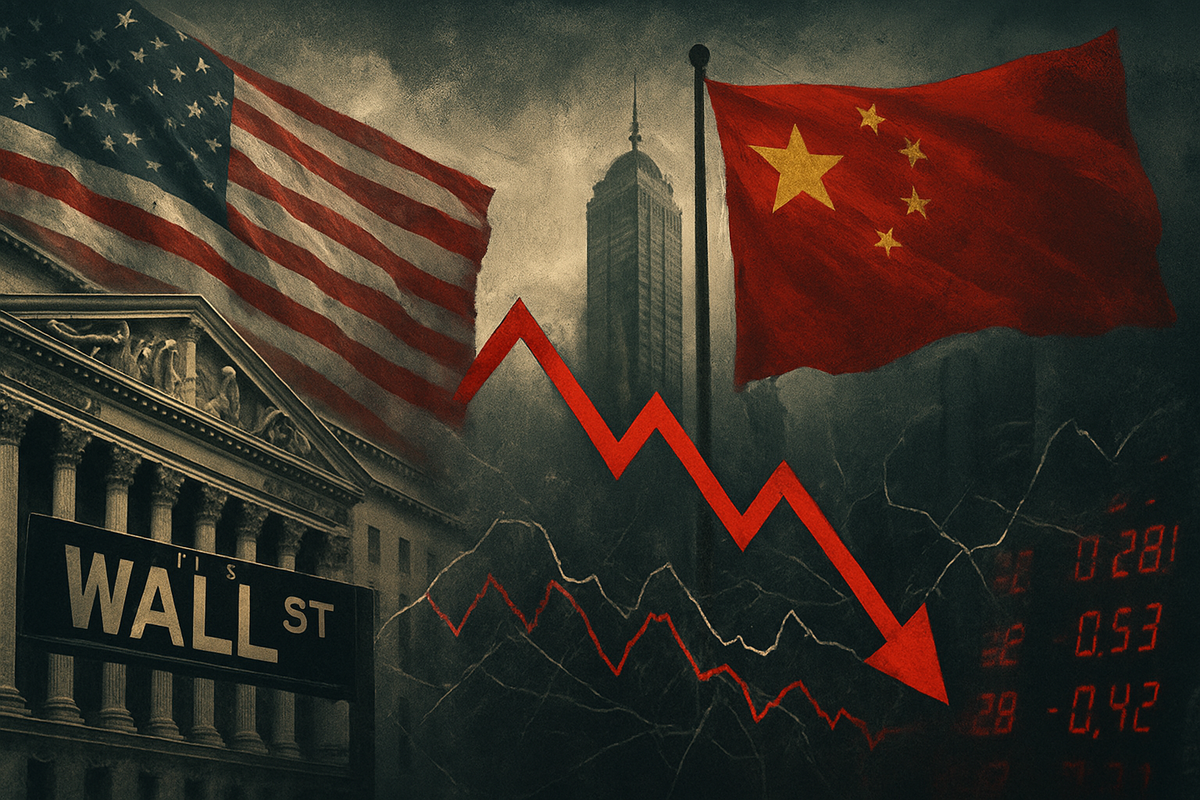
Wall Street is experiencing a significant upheaval following a sharp escalation in trade tensions between the United States and China. On October 10, 2025, renewed threats of tariffs from the US and swift countermeasures from China shattered a period of relative market calm, sending major stock indexes tumbling and prompting a rush towards safe-haven assets. This resurgence of an acrimonious trade dispute signals a potentially turbulent period for global financial markets and corporate supply chains.
Escalation Shatters Market Calm
The latest chapter in the US-China trade saga unfolded rapidly, with both economic superpowers taking aggressive stances that quickly reverberated through global markets. On October 10, 2025, US President Donald Trump announced via his Truth Social platform that he was considering "massive" new tariffs on Chinese imports, accusing Beijing of "very hostile" actions. These threats cast a shadow over a previously planned meeting with Chinese President Xi Jinping in South Korea, suggesting a diplomatic impasse.
China's response was equally swift and assertive. Citing national security concerns, Beijing implemented new export controls on rare earth elements and associated production technologies – critical minerals essential for numerous advanced industries, from consumer electronics to defense. Further escalating the situation, China imposed new port fees targeting US-owned or operated vessels, initiated an antitrust investigation into US chipmaker Qualcomm (NASDAQ: QCOM), and reportedly halted purchases of US soybeans. These strategic moves are widely interpreted as an attempt to gain leverage in any future negotiations and to counter US restrictions on semiconductor access.
The immediate fallout on Wall Street was pronounced. Major US stock indexes experienced significant declines, with the S&P 500 falling approximately 1.5%, the Dow Jones Industrial Average retreating by 0.8% to 1.2%, and the tech-heavy Nasdaq Composite dropping between 2% and 2.5%. This marked one of the sharpest single-day losses in months, signaling a dramatic spike in market volatility. Technology stocks bore the brunt of the sell-off, with the S&P 500 tech sector declining 2% and the Philadelphia SE Semiconductor index plunging 3.7%. Individual companies like Levi Strauss (NYSE: LEVI) saw their stock drop 11% amidst concerns over tariff-induced margin pressures, while Qualcomm (NASDAQ: QCOM) fell 5% following China's antitrust probe. As uncertainty gripped investors, there was a discernible flight to safety, with increased demand for Treasuries and gold.
Companies Brace for Impact: Winners and Losers Emerge
The rekindling of US-China trade tensions is poised to create a distinct landscape of winners and losers across various sectors, forcing companies to re-evaluate their supply chains, market strategies, and global dependencies. The technology and manufacturing sectors, particularly those with significant exposure to both markets, are expected to face the most immediate and profound challenges.
US companies heavily reliant on Chinese manufacturing or consumer markets, such as Apple (NASDAQ: AAPL), which manufactures a substantial portion of its products in China, and Nike (NYSE: NKE), with its extensive supply chain and sales in the region, could see increased production costs and reduced demand. The automotive industry, including giants like General Motors (NYSE: GM) and Ford (NYSE: F), which have significant sales and production facilities in China, also face potential headwinds from tariffs and disrupted supply chains. Conversely, US domestic manufacturers and agricultural producers that compete directly with Chinese imports might experience a temporary advantage, though the broader economic slowdown could temper these gains. Companies with diversified supply chains or those that have already begun reshoring operations may find themselves in a more resilient position.
On the Chinese side, export-oriented manufacturers that rely on the US market will undoubtedly suffer from new tariffs. Companies involved in rare earth processing, while initially benefiting from export controls, might face long-term challenges if global industries accelerate efforts to find alternative sources or develop substitutes. The antitrust investigation into Qualcomm (NASDAQ: QCOM) signals a broader strategy to support domestic technology champions, potentially benefiting Chinese semiconductor firms like Semiconductor Manufacturing International Corporation (SMIC) (HKEX: 0981) in the long run, even as it creates immediate pressure for US counterparts. Furthermore, Chinese companies that focus on domestic consumption or have strong partnerships within the Belt and Road Initiative countries may be better insulated from the direct impacts of US tariffs. The agricultural sector in China could also see shifts, as the halt in US soybean purchases forces a reliance on other global suppliers.
Broader Significance: A Looming Global Economic Threat
The renewed escalation of US-China trade tensions transcends immediate market reactions, posing a significant threat to broader industry trends and global economic stability. This event is not an isolated incident but rather a continuation of a strategic rivalry that has been simmering for years, characterized by a race for technological supremacy and geopolitical influence. The weaponization of trade policies, such as China's rare earth export controls and the US's tariff threats, signifies a deepening fragmentation of the global economy, pushing industries towards decoupling and regionalization.
The ripple effects are expected to extend far beyond the direct combatants. Competitors and partners in third countries, particularly those integrated into US or Chinese supply chains, could face increased uncertainty, higher costs, and pressure to choose sides. For instance, European automakers or electronics manufacturers sourcing components from both the US and China might encounter significant disruptions. Regulatory and policy implications are also profound, with governments worldwide likely to review their own trade agreements and national security frameworks in response to the volatile geopolitical landscape. Historically, similar trade disputes, such as the US-Japan trade wars of the 1980s, demonstrated how protracted tensions can lead to significant industrial restructuring and shifts in global economic power, albeit with different technological and geopolitical contexts. The current situation, however, is exacerbated by the highly interconnected nature of modern supply chains and the critical role of advanced technologies.
What Comes Next: Navigating a Fractured Global Economy
The path forward for Wall Street and global markets amidst escalating US-China trade tensions is fraught with uncertainty, presenting both significant challenges and potential, albeit risky, opportunities. In the short term, market volatility is expected to remain high as investors react to every development, rumor, or official statement from Washington and Beijing. Companies will likely prioritize supply chain resilience, accelerating efforts to diversify manufacturing bases away from heavy reliance on either nation. This could mean increased investment in countries like Vietnam, India, or Mexico, leading to a reallocation of capital and shifts in global trade flows.
Long-term possibilities include a more pronounced decoupling of the US and Chinese economies, particularly in strategic sectors like semiconductors, AI, and advanced manufacturing. This could foster the growth of parallel technological ecosystems, with each bloc developing its own standards and supply chains. For businesses, strategic pivots will be essential, requiring a re-evaluation of market access, investment strategies, and geopolitical risk assessments. Companies with robust government relations capabilities and those agile enough to adapt to rapidly changing regulatory environments may fare better. Market opportunities could emerge for domestic industries in both the US and China that can fill gaps left by reduced cross-border trade, as well as for third-party countries and companies that can serve as neutral manufacturing or trading hubs. However, the overarching challenge remains the potential for a global economic slowdown, making any opportunities highly dependent on broader market stability.
Potential scenarios range from a negotiated de-escalation, which could bring temporary relief to markets, to a full-blown trade war accompanied by broader geopolitical confrontation. A "cold tech war" scenario, where technology competition intensifies without direct military conflict, seems increasingly plausible. Investors should prepare for continued market segmentation, increased protectionism, and a sustained focus on national economic security.
Wrap-Up: A New Era of Geopolitical Investing
The recent escalation in US-China trade tensions marks a pivotal moment for global financial markets, signaling a new era where geopolitical considerations are inextricably linked with investment decisions. The immediate market downturn on October 10, 2025, underscored the fragility of the current economic landscape and the profound impact that renewed protectionist measures can have on investor sentiment and corporate valuations. The key takeaway is that the era of seamlessly integrated global supply chains is under severe strain, compelling businesses and investors to adapt to a more fragmented and unpredictable world.
Moving forward, the market will be characterized by increased volatility and a heightened focus on corporate resilience. Companies that have proactively diversified their supply chains, invested in domestic production capabilities, or developed strong regional partnerships will likely be better positioned to navigate the choppy waters ahead. Investors should assess portfolios not just on traditional financial metrics but also on geopolitical risk exposure, looking for companies with strong balance sheets, adaptable business models, and a clear strategy for operating in a potentially bifurcated global economy.
The lasting impact of this renewed trade friction could be a fundamental reshaping of global trade routes, technological development, and international economic cooperation. What investors should watch for in the coming months includes any signs of diplomatic engagement or de-escalation, the effectiveness of China's rare earth export controls, the reactions of other major economies, and the earnings reports of multinational corporations, which will provide tangible evidence of the trade war's impact on their bottom lines. This is not merely a transient market event but a significant shift towards a more nationalistic and competitive global economic order.
This content is intended for informational purposes only and is not financial advice






